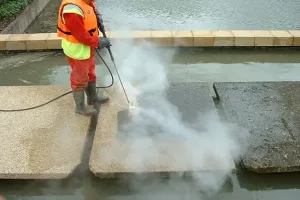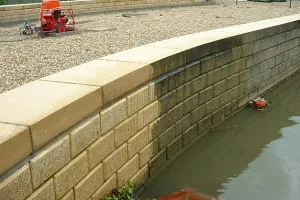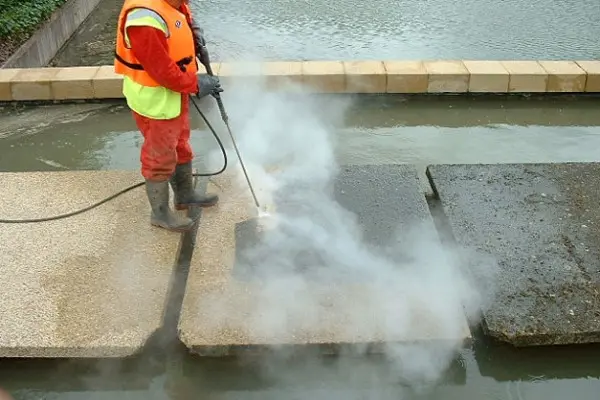Cleaning Methods
There are many different ways of cleaning buildings, and the method employed will depend upon many factors such as construction materials, the extent of deterioration, and the degree and nature of the soiling – some of the forms used include:
- Water cleaning
- Traditional Masons Nebulous Water Cleaning
- Low pressure air abrasive systems (TORC)
- Super Heated systems (DOFF and Therma Tech)
- How water pressure
- Abrasive cleaning
- Poultice cleaning
- Paint removers
- AGS (Anti-Graffiti System)
- Tensid approved contractor – www.tensid.com
- Blast cleaning
- Chemical cleaning
- Sika Approved Contractor
We are fully equipped with some of the most conservation-minded machinery and strive to ensure the most sympathetic approach is selected. We are approved contractors for both TORC, DOFF and Tensid and hold full stock of all products and machinery.
Our operatives have a wealth of experience in all systems and processes -our Masons are time served and trained – some of our members now have two of their generations within our Company. We currently have an ongoing commitment to the new (2006) “Façade Preservation” Apprenticeship scheme whereby our newer cleaning operatives will be trained for a minimum of 2 years under this apprenticeship prior to being permitted to undertake any cleaning works.
Cleaning
There are many ways to clean buildings/facades and the method employed will depend on may factors including what is essential and what is desirable.
SRS are fully aware of the unforgivable historic damage that inexperienced contractors have caused in the past using over-aggressive systems and unqualified workmanship to many beautiful buildings across the UK.
Works should only be undertaken in line with current BSI 8221-2 taking into consideration the nature and condition of the substrate.
The removal of soiling is often a source of long term deterioration may include atmospheric, metallic staining, pigeon protection gels, lime wash, algae,paint and graffiti and the differing methods of removal will depend on the results required and the friability and stone type. Architectural surfaces can build up a patina due to airborne particles, weathering cycles and the mineralogy of the stone itself. Unlike surface dirt, the patina does not simply lie across the surface of the stone but is combined to varying depths within the masonry. Although not damaging in itself the removal of patina must be undertaken carefully as inappropriate methods could destroy and weaken the substrate or more commonly mobilise the minerals beneath surface resulting in discolouration.
Our in-house fully trained facade cleaners/restorers will offer the best alternative to ensure best outcome. The use of Therma Tech, DOFF, Torik, JOS/TORC, nebulous water, latex or sympathetic approved chemicals will be considered for the best outcome. Trial areas will be undertaken with cleaning conditional surveys undertaken prior to any works commencing.
Graffiti removal : speed is of the essence for the removal of graffiti not only for best results but also to avoid the ongoing defacing. It is essential that only the most sympathetic methods and products are used to ensure the stone is not damaged. Special sacrificial coatings can be applied should the project warrant which ensures that graffiti can be washed away quicker without detrimental damage – however our team will assess the porosity of the stone before recommending sacrificial or non-sacrificial coatings as it is imperative the stone can continue to breathe to avoid other inherent problems in the future.
Repairs and Repointing
We have a full experienced team who can advise you on the reasons for the decay, analysis of the mortar and masonry and a solution to the problem. This may include repointing with the use of lime putty and hydraulic limes using the correct mix of suitable graded size of sands, dusts and pigments. Stone repairs may be required where stone has been damaged or simply worn away with time, our team can recommend the most suitable option for your project be it and indent / replacement or mortar repair.
Prior to repairs being carried out it is essential to ascertain factors which my be causing decay such as water ingress or limestone run off of possibly corroding metal fixings.
Unsuitable Mortar joints can be the cause of damage to the fabric of a building due to poor workmanship and incorrect mortars. Generally mortar that has been installed which is harder than the masonry itself will cause damage.
Pointing helps keep a building dry by preventing rainwater entering but also allowing the masonry to expel moisture. Failure to select the correct mortar will cause the masonry to fail (stone delaminating, frost damage and visible signs of crystallisation ).
The Initial Survey
In order to assess the need for cleaning and prior to any recommendations Stone Restoration Services will complete a thorough survey. Our tender document will identify the material and any relevant factors which may have gone unnoticed (for example formulations of mortars, stone misstated on documentation) and any repairs, re-pointing, or visible damage.
In addition to the general criteria the context of the building itself, its history, construction, location and proximity to other buildings etc will also be borne in mind. The type of soiling /staining and best appropriate cleaning method will be detailed in our documentation and bill of quantities.
Stone Restoration Services are experienced in all different cleaning methods – there are positive and negative points to all methods and there is rarely a single method suitable for all situations. The least harmful method or combination of methods will be selected for each case. It is generally agreed that a sample area be carefully carried out on inconspicuous areas, to demonstrate the end result, for the client’s consideration.
TORC
Stone Restoration Services are an approved TORC Contractor and own a number of systems. This ensures that any cleaning contract can be commenced and completed effectively and efficiently.
The Torc system is well recognised for its gentle yet effective swirling vortex cleaning using a mixture of low air pressure, a little water and a safe inert powder/material.The system also has the added advantage of water saving “stator” which also allow lower amounts of granulates required – thus eradicating the danger of over saturation of the substrate.

DOFF and Therma tech

The desired pressure can be variably adjusted by the operator and is independent of temperature settings.
Within the heater unit, the temperature can be increased up to 150°C if necessary, before it passes through a heat resistant nozzle and onto the surface to be cleaned.

Nebulous Spray
Nebulous spray – also known as intermittent mist spray – is a development of low-pressure water washing and is probably the least aggressive form of cleaning.
Water is passed through a very fine mesh or filter to create a mist that is then passed through fine nozzles. Its application is particularly useful where water-soluble dirt is present.The aim is to apply the minimum amount of water for the minimum duration to soften the dirt, thereby enabling its removal by agitating.
When using a the Nebulous Spray system, the level of water may be controlled electronically or by timers, allowing pulse or intermittent spraying, to avoid ever having water running down the face of the building. Before starting, the porosity of the stone can be assessed in order to balance the amount of water and duration required. By comparison low pressure water washing risks saturating the masonry which may cause corrosion of fixings or internal building damage.
